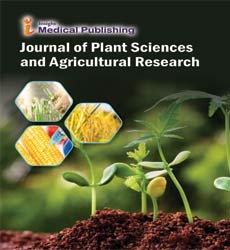Plant Resistance for Effective Pest Control in Agriculture
Bao Li*
Department of Agriculture, University of Sydney, Sydney, Australia
- *Corresponding Author:
- Bao Li
Department of Agriculture, University of Sydney, Sydney,
Australia,
E-mail: li_b@ufsc.au
Received date: August 26, 2024, Manuscript No. IPJPSAR-24-19144; Editor assigned date: August 28, 2024, PreQC No. IPJPSAR-24-19144 (PQ); Reviewed date: September 11, 2024, QC No. IPJPSAR-24-19144; Revised date: September 18, 2024, Manuscript No. IPJPSAR-24-19144 (R); Published date: September 25, 2024, DOI: 10.36648/ipjpsar.8.3.153
Citation: Li B (2024) Plant Resistance for Effective Pest Control in Agriculture. J Plant Sci Agri Res Vol.8 No.3: 153.
Description
Plant resistance, also known as plant immunity or plant defense, refers to the ability of plants to withstand or tolerate attacks from pests, pathogens and environmental stresses. It is a important component of plant health and plays a significant role in determining crop productivity, yield stability and agricultural sustainability. Plant resistance mechanisms can be broadly categorized into two main types: Pre-existing (constitutive) resistance and inducible resistance, each of which involves a complex exchange of genetic, biochemical and physiological factors.
Pre-existing resistance, also known as basal resistance, refers to the inherent ability of plants to resist or tolerate certain pests or pathogens without prior exposure or activation of specific defense responses. This form of resistance is often constitutively expressed and is conferred by genetic factors inherited from the plant's genotype. Pre-existing resistance mechanisms include physical barriers such as thickened cell walls, cuticles and trichomes, as well as chemical defenses such as secondary metabolites, antimicrobial peptides and toxic compounds that deter or inhibit the growth and development of pests and pathogens.
Agricultural practices
Inducible resistance, on the other hand, is activated in response to the presence of pests or pathogens and involves the rapid and specific induction of defense responses customized to combat the invading organism. Inducible resistance mechanisms are triggered by recognition of Pathogen-Associated Molecular Patterns (PAMPs) or Damage-Associated Molecular Patterns (DAMPs) by Pattern Recognition Receptors (PRRs) on the plant cell surface.
Plant resistance can manifest in various forms, including antixenosis (non-preference), antibiosis (inhibitory effects on pests or pathogens) and tolerance (ability to withstand damage without significant yield loss). Antixenosis mechanisms deter pests or pathogens from feeding or ovipositing on the plant by making it less attractive or suitable as a host. Antibiosis mechanisms inhibit the growth, development, or reproduction of pests or pathogens through toxic or inhibitory effects. Tolerance mechanisms enable plants to endure or recover from damage caused by pests or pathogens without suffering significant yield losses.
Plant resistance is a complex trait influenced by multiple genetic and environmental factors, as well as interactions between the plant, the pest or pathogen, and the environment. Genetic variation in resistance traits exists both within and among plant species, providing the raw material for plant breeding and genetic improvement programs aimed at developing crop varieties with enhanced resistance to pests and diseases. Traditional breeding methods, such as hybridization, selection and backcrossing, have been used to introgress resistance genes from wild relatives or related species into cultivated crops, leading to the development of resistant varieties with improved agronomic performance and durability.
In addition to conventional breeding approaches, genetic engineering techniques offer powerful tools for enhancing plant resistance by introducing or modulating specific resistance genes or pathways. Transgenic crops expressing genes encoding insecticidal proteins (e.g., Bt crops) or pathogen-derived resistance proteins (e.g., virus-resistant crops) have been developed to provide effective and sustainable solutions for pest and disease management. Moreover, genome editing technologies such as CRISPR-Cas9 enable precise modification of endogenous resistance genes to enhance their efficacy and broaden their spectrum of action.
Plant resistance is not only important for crop protection and agricultural sustainability but also for ecological balance and environmental health. By reducing the reliance on chemical pesticides and encourage the development of resilient crop varieties, plant resistance contributes to Integrated Pest Management (IPM) strategies that promote biodiversity, conserve natural resources and minimize the negative impacts of agriculture on ecosystems and human health.
Conclusion
Plant resistance is a multifaceted and dynamic phenomenon that surround a wide range of mechanisms and interactions involved in plant defense against pests, pathogens and environmental stresses. From constitutive barriers to inducible responses, plants have evolved sophisticated strategies to withstand and overcome challenges to their health and productivity. By harnessing the power of plant resistance through breeding, genetic engineering and sustainable agricultural practices, we can enhance crop resilience, reduce environmental impacts and ensure food security for future generations.
Open Access Journals
- Aquaculture & Veterinary Science
- Chemistry & Chemical Sciences
- Clinical Sciences
- Engineering
- General Science
- Genetics & Molecular Biology
- Health Care & Nursing
- Immunology & Microbiology
- Materials Science
- Mathematics & Physics
- Medical Sciences
- Neurology & Psychiatry
- Oncology & Cancer Science
- Pharmaceutical Sciences
